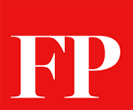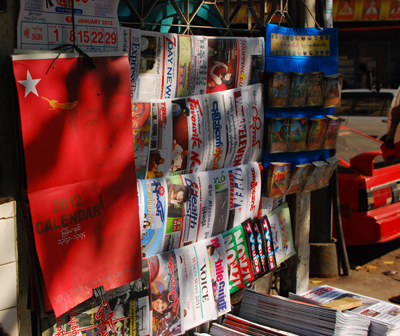
Myanmar may be opening to democracy, but just how free is the country’s notoriously closed media?
![]()
YANGON, Myanmar– The most visible sign of Myanmar’s recent opening can be seen on the walls of the city’s monasteries and tea shops, on its newsstands and on the dashboards of its battered taxi cabs. Portraits of democracy icon Aung San Suu Kyi — once a ticket to arrest and interrogation by the military authorities — are now displayed openly around Yangon, the country’s largest city and former capital.
The appearance of the petite Nobel laureate is a startling reminder of how far controls have been relaxed here since March, when a civilian government under President Thein Sein replaced the old ruling clique of generals. So far, Thein Sein has engineered the country’s opening masterfully: His government’s series of sweeping reforms, including the rapid normalization of ties with the United States, has brought Suu Kyi’s National League for Democracy (NLD), Myanmar’s main opposition party, back to the table. The party boycotted nationwide elections in November 2010, citing unfair electoral rules, but has now announced it will participate in by-elections on April 1, and “The Lady” — as she is affectionately known to her supporters — will stand for elected office for the first time.
As observers debate just how far this “Myanmar Spring” will proceed, the transformation of the country’s media, which has covered the NLD’s return to the fold in previously unthinkable detail, offers some insight into the dynamics of the reform process. Just last year, Freedom House described Myanmar’s press as “among the most tightly restricted in the world.” All daily newspapers and broadcast media — headed by the dour flagship daily, The New Light of Myanmar — were run by the state, and featured bland coverage of official ribbon-cuttings alongside rants against the “spies” working for foreign media organizations.
Though Myanmar has a plethora of privately owned weekly and monthly news and lifestyle journals, these were under the close watch of the sinister-sounding Press Scrutiny and Registration Division (PSRD). Editors were forced to submit proofs to the PSRD before publication, and would receive them back with “unsuitable” content scratched out in red ink. This limited news coverage to a narrow range of politically innocuous topics, and publications were often forced to run junta-produced material. Journalists trying to work outside the system were punished harshly. For four consecutive years, the Committee to Protect Journalists has ranked Myanmar among the world’s five worst jailers of the press, claiming, as of September 2011, that at least 14 media workers were languishing in prison for their work.
Since March, however, restrictions have been loosened. The government claims it is replacing the old system of PSRD “pre-censorship” with a new system under which publications will be “reviewed” after they hit the newsstands. Under the new rules, more than half of Myanmar’s publications, including business, lifestyle, and crime journals, have now been made exempt from pre-publication censorship (though those dealing with news, education, and religion remain under the old system). Tint Swe, then-head of the PSRD, even suggested in late 2010 that his own office be abolished in the move away from direct censorship, and officials have promised to extend the rules to cover all remaining genres once a new media law is promulgated later this year.
An editor at the weekly Myanmar Times, which publishes in both Burmese and English, said relaxations on the press are occurring “so quickly that we are publishing articles that would have been censored completely just one or two months previous.” Besides reporting on Suu Kyi, previously off-limit topics included ethnic conflicts, human rights issues, and the controversial Chinese-funded Myitsone Dam project, which Thein Sein suspended in August.
“Obviously there are still limitations, but the difference in press freedom between, for example, early 2010 and late 2011, is like night and day,” said the Myanmar Times editor, who did not wish to be named. On Jan. 13, the government released a fresh batch of political prisoners, including dissident journalists like Zaw Thet Htwe, who was arrested in 2008 for helping mount a private effort to relieve victims of Cyclone Nargis, and blogger Nay Phone Latt, who was slapped with a 12-year prison sentence for writing about the monk-led anti-government protests in 2007. Also among them were 13 journalists imprisoned for working as undercover correspondents for the Democratic Voice of Burma, an exile media organization.
By Myanmar’s lowly benchmark, these changes are drastic; but as always, a gulf remains between relative and absolute measures of the country’s democratic progress.Despite the recent changes to media rules, it remains unclear if Myanmar’s leadership has any interest in creating an unfettered press. Some have argued that the government’s main aim is to re-engage with the West in a bid to balance the influence of China, and to rehabilitate the country’s image as an international pariah.
One Yangon-based local journalist, who spoke on condition of anonymity, said changes to the media were a subordinate “by-product” of this wider process of reform. Unlike the old generals, who feared independent press scrutiny, the new breed of politicians have discovered that engaging the media — for example, by holding press conferences and taking unscripted questions from the audience — can be used to bolster their own popularity. “They have started to enjoy using the media for their own interests,” the journalist said. And as living standards rise, the government’s plan is that people “will keep their mouths shut and not say anything about politics,” an approach that mirrors those in countries like China, Vietnam, and Singapore — hardly paragons of press freedom.

Newspapers and magazines for sale in Rangoon (Sebastian Strangio)
“The end-game here is not some kind of rapid transition to a genuine democracy, but an evolution of a more sophisticated authoritarian structure,” said David Scott Mathieson, a Myanmar researcher for Human Rights Watch.
Indeed, the new system of censorship-after-the-fact still gives the authorities a great deal of control over what hits the stands. While certain sensitive topics can now be covered freely, the president of the Norway-based Myanmar Media Association, Maung Maung Myint, said the onus for regulating content has now been put on the media itself, which has been “warned to take ‘responsibilities’ that come with these new freedoms.”
The issue was highlighted — unintentionally, perhaps — by the new head of the PSRD at a meeting on Dec. 6, when he hailed the move of shifting the burden of censorship onto editors and publishers. The official said authorities had so far issued 86 warnings to journals and 37 to magazines, mostly over the publications of “sexy” photos by entertainment publications, but that on the whole, “editors can do self-censorship very well.”
As the new media regime is extended to more sensitive news journals, observers predicted journalists and editors would have difficulty second-guessing limits that were previously set by the PSRD, leaving them open to sanction. “Publishers are also more cautious,” said the Yangon journalist, “because they have to pay a big fine if they publish something wrong.”
Aung Zaw, founding editor of The Irrawaddy magazine, a Thailand-based exile publication, said that while an increase in self-censorship — both “consciously and unconsciously” — was better than direct censorship, it could not be described as a great leap forward for press freedoms. “Besides [printing] Aung San Suu Kyi’s photo… how deeply can investigators write about the change of political landscape in Myanmar?” he said. “It’s a brief moment of freedom, and then they tighten the screw again.”
Myanmar’s best hope may lie with those journalists and editors inside the country who are willing to test the limits of the new rules — whatever the sanction. One such publication is the Burmese journal Weekly Eleven News, which last month received the Best Media Organization prize from Reporters Without Borders. In announcing the award, the Paris-based watchdog wrote that the publication had used “extraordinary ingenuity to slip through the censorship net and inform the Burmese public” and will play a “key role” in the new era of reforms.
Maung Wuntha, a veteran Burmese journalist and editor of The People’s Age Journal, said that whatever the motivation for the current reforms, he and other journalists would continue to push the envelope. He told me that he recently submitted to the PSRD an article criticizing the government’s designation of political prisoners as “criminals,” something that would have previously ended up on the censors’ cutting-room floor. Surprisingly, nothing happened, and the controversial phrase appeared in print. “Now I write very daring paragraphs and daring sentences, and very rarely my lines are cut,” he said.
It may be too optimistic to predict that the carefully calibrated reform process will take on an inevitable momentum of its own, uncorking a democratic genie that the authorities will find hard to put back in the bottle, but there are signs that the Myanmar Spring is having unexpected outcomes. It would be no small irony if one of the world’s most repressive states attained democracy and a free press not by design, but in the manner that John Robert Seeley famously described the British acquisition of their overseas empire — in a fit of absence of mind.
Whatever happens next, Maung Wuntha, who began his journalistic career under the military regime in 1964 and spent much of the 1990s in and out of prison, said the world will be watching closely. “I want to fight it,” he said of his country’s media restrictions. “If they take action against me I will tell the world.”
[Published by Foreign Policy, January 20, 2012]


